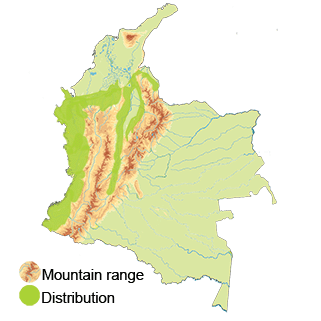White-tipped Sicklebill
The White-tipped Sicklebill (Eutoxeres aquila) Read in Spanish
Appearance: The White-tipped Sicklebill is a medium-sized hummingbird with a distinctive curved bill. It has iridescent green plumage on its upperparts and a white-tipped tail, which gives it its name. The bill of the White-tipped Sicklebill is long and curved, adapted for feeding on nectar from flowers with long corollas.
Habitat: These hummingbirds are found in the montane forests and cloud forests of the Andes mountains in Colombia. They are typically found at higher elevations, preferring the cool and moist environments of the cloud forest.
Behavior: The White-tipped Sicklebill primarily feeds on nectar from a variety of flowers using its specialized bill. It may also consume insects and spiders for protein. They are known for their agile and acrobatic flight patterns, allowing them to maneuver through dense vegetation in search of food and mates. These birds can be territorial and may defend feeding territories against intruders.
Breeding: Males may perform elaborate courtship displays, including aerial displays and vocalizations, to attract females. The female constructs a small cup-shaped nest made of plant fibers and spider silk, placed on a tree branch or in vegetation. The female alone incubates the eggs, which typically hatch after about two weeks. Both parents may contribute to feeding and caring for the chicks until they are ready to fledge.
Conservation Status: The White-tipped Sicklebill is considered a species of least concern according to the IUCN Red List.
Distribution
The White-tipped Sicklebill (Eutoxeres aquila)
- Western Andes: The White-tipped Sicklebill can be found in parts of the Western Andes region in Colombia, which includes departments such as Antioquia, Risaralda, Caldas, and Valle del Cauca. Within this region, the hummingbird may inhabit high-altitude cloud forests and montane forests characterized by rich biodiversity and unique plant species.
- Central Andes: This species is also present in the Central Andes region of Colombia, which includes departments like Quindio, Tolima, and Cundinamarca. In the Central Andes, the White-tipped Sicklebill can be encountered in cloud forests and mountainous areas with suitable habitat for feeding, nesting, and breeding.
- Eastern Andes: In the Eastern Andes, which encompass regions like Boyaca and Norte de Santander, the White-tipped Sicklebill may be found in specific areas with appropriate environmental conditions. This region offers diverse ecosystems ranging from high-altitude paramo to cloud forests, providing suitable habitats for various bird species, including hummingbirds.
- Northern Andes: The White-tipped Sicklebill's distribution in the Northern Andes, covering regions like Cauca and Santander, is influenced by the presence of montane forests and cloud forests at different elevations. These areas offer a variety of flowering plant species that provide nectar sources for the hummingbird's diet.
Taxonomy
The White-tipped Sicklebill (Eutoxeres aquila)
- Kingdom: Animalia
- Phylum: Chordata
- Class: Aves (Birds)
- Order: Caprimulgiformes
- Family: Trochilidae
- Genus: Eutoxeres
- Species: Eutoxeres aquila
Vocalization
The White-tipped Sicklebill (Eutoxeres aquila)
- Chirping and Chattering: White-tipped Sicklebills are known to produce a variety of high-pitched chirps and chatters as part of their vocal repertoire. These sounds may be used for general communication between individuals, signaling alarm, or expressing excitement.
- Whistling Calls: The White-tipped Sicklebill may also emit whistling calls that are melodious and can carry over long distances. These whistling calls can serve as territorial signals to establish boundaries within their habitats or attract potential mates during the breeding season.
- Buzzing Sounds: Some hummingbirds, including the White-tipped Sicklebill, are capable of producing rapid buzzing sounds with their wings during flight. These buzzing sounds, often created by the rapid flapping of their wings, can be a part of courtship displays or territorial interactions with other individuals.
- Singing and Trilling: During courtship displays or when defending territories, White-tipped Sicklebills may engage in more elaborate vocalizations, including singing and trilling. These vocalizations can be complex and rhythmic, potentially serving to attract mates or assert dominance within their social groups.
- Silent Moments: While White-tipped Sicklebills are known for their vocalizations, they also have periods of relative silence, especially during resting or feeding activities. Their vocalizations are more prominent during specific times of the day, such as dawn and dusk, when activity levels and social interactions peak.




